The Complete Light Oak Sideboard Buying Guide
Expert advice on choosing, sizing, and styling the perfect sideboard for your home
Why Light Oak Sideboards Stand Out
Light oak sideboards offer the perfect balance of warmth and versatility. The pale, honey-toned wood brightens spaces, complements both modern and traditional interiors, and develops character over time. Unlike veneer alternatives, solid light oak is built to last decades while becoming more beautiful with age.
Showing all 10 resultsSorted by latest
-
Sale!

small sideboard light oak
Original price was: £455.00.£335.00Current price is: £335.00. Add to basket -
Sale!
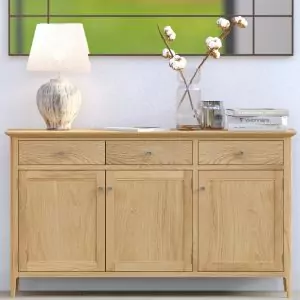
large light oak sideboard
Original price was: £605.00.£455.00Current price is: £455.00. Add to basket -
Sale!
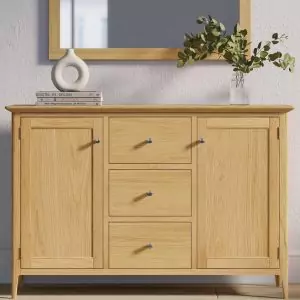
London Oak Large 2 Door 3 Drawer Sideboard
Original price was: £555.00.£390.00Current price is: £390.00. Add to basket -
Sale!
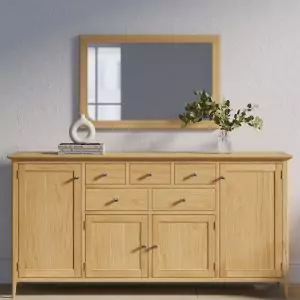
oak extra large sideboard
Original price was: £760.00.£525.00Current price is: £525.00. Add to basket -
Sale!

Light Oak Cabinet
Original price was: £330.00.£225.00Current price is: £225.00. Add to basket -
Sale!
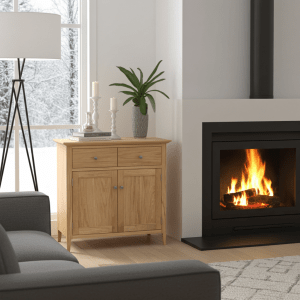
Light Oak Small Sideboard
Original price was: £355.00.£265.00Current price is: £265.00. Add to basket -
Sale!
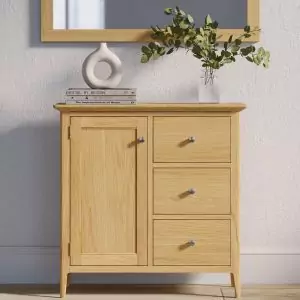
Light Oak Hallway Cabinet
Original price was: £345.00.£235.00Current price is: £235.00. Add to basket -
Sale!

Light Oak Large Dresser
Original price was: £1,110.00.£830.00Current price is: £830.00. Add to basket -
Sale!

Light Oak Glazed Bookcase
Original price was: £435.00.£305.00Current price is: £305.00. Add to basket -
Sale!

Light Oak Small Cupboard
Original price was: £230.00.£170.00Current price is: £170.00. Add to basket
Before You Shop: The Essential Measurements
Rushing through measurements is the #1 reason buyers regret their furniture choices. Take 10 minutes now to save yourself from delivery day disappointments.
Size Categories: Find Your Perfect Fit
Light oak sideboards come in distinct size ranges, each serving different needs and spaces. Understanding these categories helps narrow your choices dramatically.
Compact (70-90cm)
Best for: Hallways, bedrooms, small living rooms, tight spaces
Storage capacity: 2-3 drawers or 2 doors; ideal for seasonal items, keys, documents
Style impact: Creates focused accent without overwhelming
Standard (100-140cm)
Best for: Dining rooms, medium living rooms, most homes
Storage capacity: 3-4 drawers + 2-3 cupboards; perfect for dinnerware, linens, books
Style impact: Statement piece without dominating the room
Large (150-200cm)
Best for: Open-plan living, expansive dining areas, media storage
Storage capacity: Maximum storage with multiple compartments
Style impact: Architectural focal point that anchors the room
Construction Quality: What Separates Good From Great
Not all oak sideboards are created equal. Understanding construction quality helps you identify furniture that will last 20+ years.
| Feature | Quality Standard | Why It Matters |
|---|---|---|
| Solid Oak Frame | Visible sides, top, and back in genuine oak | Ensures durability and allows future refinishing |
| Dovetail Joints | Hand-cut or precision machine joints on drawers | Prevents drawer wobble and sag after years of use |
| Drawer Runners | Soft-close or quality ball-bearing mechanisms | Smooth operation and prevents slamming damage |
| Hinges | Concealed or doweled brass/metal hinges | Prevents door sag and ensures years of smooth opening |
| Internal Shelving | Adjustable solid shelves with support pegs | Flexibility for different items; prevents permanent dents |
| Finish | Wax, oil, or lacquer (NOT paint hiding poor wood) | Shows off grain; allows touch-ups and refinishing |
Light Oak vs. Other Finishes: The Comparison
Light oak is just one option. Here’s how it compares to alternatives you might encounter:
Cons: Shows dust more readily, requires occasional waxing, higher initial cost
Cost: £400-£800+ for quality piece
Cons: Can feel heavy, less versatile, dates faster
Cost: Similar to light oak
Cons: Cannot be refinished, veneer can chip, less durable
Cost: £200-£500
Cons: Hides grain beauty, paint can chip, limits refinish options
Cost: £350-£700
Cons: Won’t last, can’t be refinished, swells with moisture
Cost: £100-£300
Where Light Oak Works Best: Room-by-Room Guide
Dining Room (The Classic Choice)
This is where sideboards originated. A light oak sideboard anchors the dining room, stores dinnerware and linens, and provides a display surface for serving or family photos. Position it on the wall opposite or perpendicular to your dining table for visual balance.
- Use the top surface for buffet serving or elegant table décor
- Store everyday dishes in accessible drawers; formal set in doors below
- Hang a mirror above to amplify light and create visual height
- Add table lamps on the surface for ambient evening lighting
Living Room (Modern Storage)
Light oak sideboards work brilliantly as media storage or display units in living rooms, offering a softer alternative to dark entertainment units. The pale wood keeps the space feeling open and airy.
- Use for books, board games, board game collection, or AV equipment
- Position under a TV (ensure width is appropriate and depth accommodates equipment)
- Display family photos, plants, or decorative objects on the surface
- Pair with a mirror to reflect light and create a focal point
Hallway (First Impression)
A compact light oak sideboard in a hallway creates an immediate welcoming impression. It provides practical storage for keys, shoes, and everyday items while serving as a decorative anchor.
- Choose compact sizes (70-90cm) to avoid crowding narrow spaces
- Use drawers for shoes and accessories; doors for bags and coats
- Style with a mirror above and ambient lighting for a hotel-like entry
- Add a wooden tray on top to corral keys and mail
Bedroom (Unexpected Elegance)
Many overlook bedroom sideboards, but they add both storage and style. Light oak feels less imposing than dressers and works beautifully as a room divider or at the foot of a bed.
- Use for off-season clothing, bedding, or accessories
- Position at the foot of the bed or perpendicular to a wall
- Layer with textiles and decorative objects to soften the look
Styling Your Light Oak Sideboard: Design Tips
The 3-Tier Styling Rule
Lower tier (base): Keep clean and clear for visual lightness
Middle tier (surface): Functional items (small storage boxes, trays) mixed with decorative (books, plants)
Upper tier (above/behind): Artwork, mirror, or wall-mounted shelving for visual completion
Color Pairings That Work
- Whites & creams: Creates airy, Scandinavian feel
- Greens & blues: Natural, calming atmosphere
- Greys & blacks: Contemporary, sophisticated look
- Warm earth tones: Cozy, traditional aesthetic
- Bold jewel tones: Modern, artistic statement
Maintenance & Care: Keeping Light Oak Beautiful
Weekly Care
- Dust with a soft, dry microfiber cloth along the wood grain
- Wipe spills immediately with a barely-damp cloth
- Avoid leaving water rings—always use coasters for glasses and cups
Monthly Care
- Clean with a wood-specific cleaner (pH-neutral)
- Polish drawers and hinges to maintain smooth operation
- Check for any signs of damage or loose hardware
Seasonal Care
- Re-apply wax or oil finish (if your sideboard has this finish) every 6-12 months
- Inspect joints and hinges for tightness
- Use furniture conditioner to keep wood from drying out
What to Avoid
- Direct sunlight: Fades the wood; use curtains or UV-protective film
- Extreme heat: Never place near radiators or direct heat sources
- Excessive moisture: Keep away from kitchens and bathrooms if possible
- Harsh chemicals: Avoid bleach, acetone, or furniture polish with silicone
- Heavy impacts: Protect edges from chair bumps and moving furniture
Frequently Asked Questions
Q: Is solid light oak worth the extra cost over veneer?Absolutely, if you plan to keep the sideboard 10+ years. Solid oak can be refinished, sanded down if scratched, and improves with age. Veneer can chip irreparably. The cost difference pays for itself through longevity.
Q: Will my light oak sideboard match my other furniture?Light oak is remarkably versatile. It pairs well with most wood tones, works in both traditional and modern spaces, and complements virtually any paint color. If you have very dark furniture, choose a lighter oak shade.
Q: Can I use a light oak sideboard in a small space?Yes—in fact, light oak is ideal for small spaces because it reflects light and doesn’t feel heavy. Choose compact sizes (70-90cm wide) and keep the top surface mostly clear to maintain visual openness.
Q: How do I protect my light oak from scratches and dents?Use felt pads under table legs and decorative items on the surface. Keep the finish well-maintained (waxed/oiled) as this creates a protective layer. Minor scratches in waxed finishes can be touched up; lacquered finishes hide small imperfections better.
Q: Will light oak darken over time?Yes, gradually. Light oak develops a richer, honey-like patina over 5-10 years as UV light and air exposure naturally oxidize the wood. This is part of its charm and shouldn’t be considered damage.
Q: What’s the difference between light oak finishes (wax vs. lacquer vs. oil)?Wax:Natural feel, requires regular re-application, most repairable.Lacquer:Glossy, protective, low-maintenance but harder to touch up.Oil:Enhances grain, renewable, deepens over time. Choose based on your lifestyle and maintenance preference.
Making Your Final Decision: The Confidence Checklist
The Bottom Line
A quality light oak sideboard isn’t just a purchase—it’s an investment in your home’s functionality and beauty. Take time with your decision, prioritize solid oak with quality construction, and choose a piece that speaks to your lifestyle. Done right, your sideboard will be a beloved centerpiece for decades to come.
